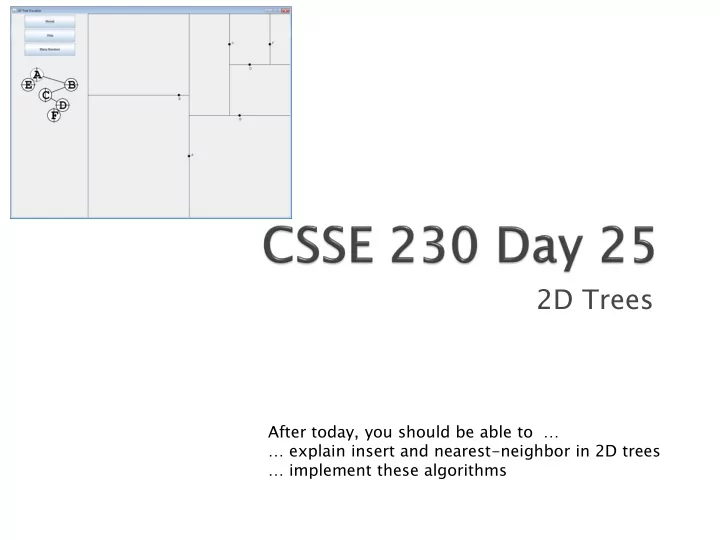

2D Trees After today, you should be able to … … explain insert and nearest -neighbor in 2D trees … implement these algorithms
1 A large set of (x,y) points Which cell phone tower is closest to me? Which image is most like this one? In general: ◦ Find the nearest neighbor of a query point (today). ◦ Find or return all points in a certain range. https://personalpages.manchester.ac.uk/staff/m.dodge/cybergeography/atlas/tower_maps_large.gif https://www.rose-hulman.edu/class/csse/csse463/201520/Slides/01%20Introduction.pdf
2a 2a List of points. Simple but slow ◦ [p1, p2, …] ◦ Find smallest of dist(q, p1), dist (q, p2), … Represe resentat ntatio ion Average rage nearest rest-nb nbr efficiency ciency List of points N
2b 2b List of points. Simple but slow Use a regular grid. ◦ 2D array of lists ◦ Faster, but which resolution? ◦ Example, M=8 Represe resentat ntatio ion Average rage nearest rest-nb nbr efficiency ciency List of points N Regular grid 1 + N/M 2 but space = N +M 2 , clustering degrades
List of points. Simple but slow Use a regular grid. ??? Represe resentat ntatio ion Average rage nearest rest-nb nbr efficiency ciency List of points N Regular grid 1 + N/M 2 but space = N + M 2 , clustering degrades ??? log N
3 Split at 70 Split at 20 etc Any value inserted to the left of 30 must be in what range?
4 Each level splits the plane in one direction only Use the insert algorithm to build a tree from points: A (0.5, 0.7) B (0.75, 0.5) C (0.7, 0.15) D (0.8, 0.25) E (0.45, 0.4) F (0.9, 0.15)
5 Initialize the closest point as the root. Recursively go to each side if it could be closer: ◦ To left/top and update closest if one found ◦ To right/bottom and update closest if one found ◦ When hit a null node, just return New idea: don’t always recurse to left/top first. Instead, first recurse to the same me side as the query point, and then only recurse to the other side if f it could yield a closer point ◦ To do this, I suggest that each node also store the bounds of rectangle it is part of
5 Initialize the closest point as the root. Recursively go to each side if it could be closer: To left/top and update closest ◦ if one found To right/bottom and update ◦ closest if one found When hit a null node, just ◦ return New idea: don’t always recurse to left/top first. Instead, recurse to the same side as the query point, and then only recurse to the other side if it could yield a closer point To do this, each node will also ◦ store the bounds of rectangle it is part of
6 List of points. Simple but slow Use a regular grid. Use a 2D tree ◦ You can find the nearest neighbor efficiently Represe resentat ntatio ion Average rage nearest rest-nb nbr efficiency ciency List of points N Regular grid 1 + N/M 2 but space = N/M 2 +1, clustering degrades 2D tree log N
7-8 Questions for thought: ◦ How would you build a 3D tree? ◦ … a k -d tree? Summarize now Assignment for this week: ◦ Implement insert(Point), contains(Point), and nearest(Point) using a 2D tree
Recommend
More recommend